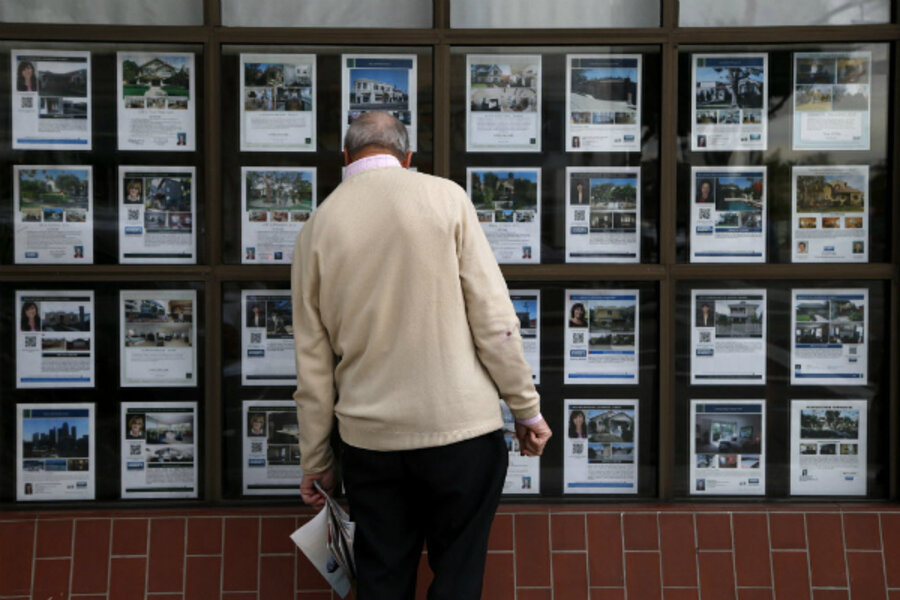Homeownership rate dips after recession – but doesn't plunge
Loading...
| Washington
Homeownership has waned under the stresses of the Great Recession and its aftermath, according to Census Bureau numbers, released Thursday.
Some 64.7 percent of US housing units were owned, rather than rented, during the period from 2010-12. That represents a meaningful drop from the level of 66.4 percent that prevailed during the prior three-year period, from 2007-09.
The downward trend isn’t necessarily a bad thing. Rather, it may be sign of the housing market normalizing after a period, before the recession, in which home-buying was pushed to what many economists viewed as unhealthy and unrealistic levels.
Today, by many measures, the US housing market is in recovery mode: Foreclosures are fading, home prices are rising, and low mortgage rates are helping to keep housing relatively affordable by historical standards.
The downward adjustment of homeownership rates has been part of that recovery process.
The downshift has been biggest in states and cities that were hit hardest by the housing bust – and that had often seen the biggest boom times a decade ago. But the drop in homeownership was a nationwide phenomenon.
Homeownership dipped in all 50 states and in all the 50 biggest metro areas between the recession period (2007-09) and the three-year aftermath period shown in the new Census report.
But the rate of homeownership ebbed only modestly in some less-populated states, dropping less than half a percentage point in Oklahoma, Montana, Wyoming, North Dakota, and South Dakota.
Ownership fell much more in Arizona (down by 3.7 percentage points), Nevada (3.4), Florida (2.4), and California (2.2). Declines of between 2 and 3 percentage points were also seen in Colorado, Georgia, Idaho, Maryland, Massachusetts, Michigan, Oregon, Rhode Island, Tennessee, Utah, and Washington.
But even in most of these states, the ownership rate remains relatively high, well above 60 percent of housing units.
Michigan, despite being hit by hard times in the auto industry and by the fiscal travails of Detroit, joins a handful of states in seeing ownership rates stay above 70 percent.
The Census Bureau defines the homeownership rate as the percentage of occupied housing units that are owned – either with a mortgage or free and clear.
Prior to the recession, the spread of dodgy lending practices such as mortgages with “interest-only” payments or no money down helped to push ownership levels to historic highs.
The fact that ownership rates haven’t plunged further, in the economic disruption of the recession, is testament both to the enduring appeal of ownership and to various economic rescue efforts put in place by the government and the Federal Reserve in 2008 and 2009.
The Fed’s regime of ultra-low interest rates, coupled with US Treasury support for the mortgage giants Fannie Mae and Freddie Mac, helped to stabilize the US job market and end a free-fall in home prices.
The Census numbers also capture price changes during three-year periods of recession (2007-09) and aftermath (2010-12).
Median home values in 43 of the 50 largest counties declined between those periods, but were little changed in most of the smallest counties, the Census Bureau found in its American Community Survey.
"The American Community Survey is the only data source that has the capability to show us how the economic situation in these smaller counties compares with the nation as a whole, as measured by these key housing indicators," Arthur Cresce, an assistant division chief at the Census Bureau, said in releasing the data.
Nationally, the median home value was $174,600 in the post-recession period, a $17,300 decline from the recession period, the report found.
Some other gauges of the housing market:
- Home prices. A more current index of home prices, from the Federal Housing Finance Agency, now sits roughly where it was in 2005, but about 10 percent below where it peaked prior the recession. This represents some sizable recovery: In 2011 the index was 20 percent below its 2007 peak.
- Loan trouble. Thanks to home price gains, fewer Americans are “under water,” with loan balances that exceed their home’s value. Some 14.5 percent of borrowers (7 million) had negative equity as of the second quarter of this year, according to CoreLogic. That’s down from about 20 percent in the first quarter and a peak of 25 percent in 2011.
- Household net worth. Overall, the net worth of US households stands at nearly $75 trillion as of this year’s second quarter, according to Federal Reserve data – compared with $57 trillion in 2008. That’s been fueled partly by share price gains for people invested in stocks. But it’s also because mortgage debt has been declining (to $9.3 trillion in the second quarter) and the value of real estate recovering (to $18.6 trillion).






